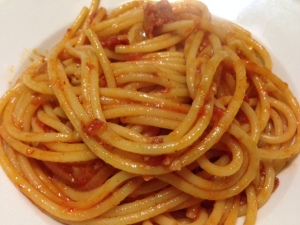If anyone knows where Frascati comes from (which is the territory immediately south and east of Rome, by the way) it’s probably the only wine that most folks can identify as coming from the Lazio region and the image of said wine is fairly accurately but also unfortunately debased. Fortunately there’s also a (mostly unknown) array of grapes and wine regions in Lazio that deserve a level of notoriety that they don’t currently enjoy, and the Cesanese variety is definitely one of them.
There are two sides to the Cesanese family of vines – a larger-berried and somewhat more pedestrian strain called Cesanese Comune and the finer smaller-berried version called Cesanese d’Affile, and this more esteemed type is the one we’re dealing with here. Though Cesanese can make up a portion of the blend of a number of appellations in Lazio, there are also three Cesanese-exclusive designations in the region. Cesanese di Olevano is a D.O.C. typically made from Cesanese Comune. The other D.O.C. is the eponymously-named Cesanese d’Affile region that is obviously made from the Cesanese d’Affile clone, mostly in and around the town of Affile. The third all-Cesanese wine region in Lazio is the one from which this evening’s wine emanates and it carries Italy’s highest appellation designation, D.O.C.G., and it goes by the name of Cesanese del Piglio.
When you eventually get a chance to sample this fairly rarely seen red, you’ll wonder, at least in terms of what it presents in the glass, why it isn’t MUCH better known and loved – it’s got a plush, polished and elegant overall character with lots of refined cherry and berry flavors that might be likened to a slighter plumper and more affable cousin of Pinot Noir. Sounds great, right? So why the obscurity? Well, the reasons are two-fold. First, all three of these regions are not very large, and Rome is a big, thirsty city, so much of the production stays in Lazio. The second issue is one involving the vine’s physiological nature – like Pinto Noir, it is very difficult to fully ripen it, and it has a particular susceptibility to a very common vine disease called powdery mildew, so while the ultimate potential for Cesanese is very high, all too little of the total production reaches this potential. But Cesanese del Piglio was not awarded a D.O.C.G. for nothing, and this particular producer consistently ranks among the finest sources for this potentially very fine vine. So if you’re in Rome, or a particularly well-curated wine shop in you neck of the woods, grab a bottle and dig it…
As the saying goes, when in Rome, do as the Romans do, so who am I to countermand? First course: the very, very Roman/Laziale dish Bucatini all’Amtriciana. Main course: butterflied and floured tranches of pan-fried pork tenderloin seasoned with fennel seed and rosemary. Side: Boiled and then sauteed broccoli rabe with garlic, breadcrumbs, anchovies and lemon juice.
Casale della Ioria Cesanese del Piglio “Campo Novo” 2012
Slightly cloudy, blackish/brown deep crimson color. Pretty aromas of chocolate-covered cherries, blood orange, strawberry preserves, aromatic red flowers, mineral, hazelnut butter, and eucalyptus. In the mouth the wine shows a smooth, soft, medium-full body with a finely polished tannic structure and a fresh and juicy acidity with flavors of red plums, myrtle, black raspberry, beeswax, sweet spices and subtle vegetable soup notes. Finishes with bitter/sweet honey notes. A decidedly elegant and feminine wine.



Tom, thanks again for another inspired post. My beloved, late mother, whose family came from Frosinone, would have adored this wine-food combination.
Tom Fiorina
By: tomfiorina on March 21, 2014
at 3:53 am
Thanks, Tom. My uncle’s family came from nearby Anagni, which as I understand it is the THE sweet spot for growing Cesanese.
By: tomciocco on March 21, 2014
at 10:15 am